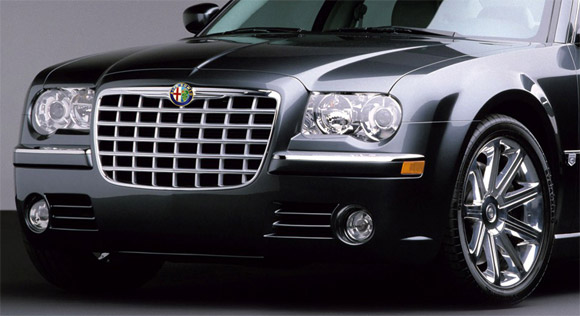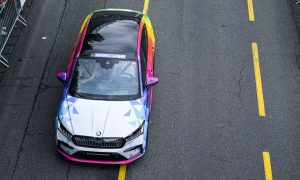
Fiat SpA’s Alfa Romeo, the maker of small and sporty cars like the Duetto Spider, will probably choose a sedan for its first U.S. model in more than 15 years, Alfa Romeo Chief Executive Officer Sergio Cravero said.
Americans are more likely to buy the Giulia sedan, the successor to the 159 automobile that Alfa Romeo sells in Europe, rather than smaller hatchbacks such as the MiTo or the new Milano, Cravero said in an interview at the company’s Turin, Italy, headquarters.
“The Giulia is a car that could be the most interesting for the U.S. market,” he said. “We need to build cars together with Chrysler that have an Alfa Romeo soul.”
The money-losing division, whose Spider was driven by Dustin Hoffman in the film “The Graduate,” will restart Alfa Romeo sales in the U.S. in 2011 or 2012 to help reach its goal of breaking even. Fiat, which owns about 20 percent of Chrysler Group LLC, will build the Giulia at a Chrysler factory and design it on the same frame as a Chrysler to save money.
Alfa Romeo, which pulled out of the U.S. in 1995, must sell 250,000 cars a year to break even and plans to add a sport utility vehicle and a larger sedan, both models that could be jointly developed with Chrysler, Cravero said.
Fiat CEO Sergio Marchionne, who also runs Chrysler, says a carmaker must produce about 1 million vehicles per platform to be profitable. Cravero aims to build the new Alfa Romeo model on the same chassis used by Chrysler to save costs and boost production the way Fiat did with its small car Panda. That model shares the underlying engineering of the Fiat 500 and Ford Ka.
Police Force
“We have to find a solution that makes sense economically,” Cravero said. “We can’t wait 10 years to see results.”
Fiat’s first car to be introduced in the U.S. since the Chrysler deal will be the 500 sub-compact, slated to be presented next year. The 500 is already undergoing tests to meet standards in that market. In June, Fiat obtained 20 percent of Chrysler and management control through an agreement that brought the U.S. No. 3 carmaker out of bankruptcy. Fiat’s mandate is to turn Chrysler around by sharing technology to build energy-efficient cars.
The 159 was introduced in 2005 and was a successor to the 1960s version used by Italy’s police force for its fleet. The new Giulia could be built on Alfa Romeo’s C-Evo platform or Chrysler’s 300C platform, with plans to be disclosed by September or October, Cravero said.
Too Heavy
The challenge is to find a platform that will work both for Chrysler and Alfa Romeo. The 300C platform, which was developed in 1995 with Mercedes-Benz, isn’t competitive enough because it’s too heavy and lacks the smooth handling of newer cars, according to Andrew Close, an auto analyst with IHS Global Insight in London. Retooling the C-Evo for a bigger car isn’t ideal either, he said.
“There are problems with both platforms,” said IHS Global Insight’s Close. “Chrysler’s 300C is very old and isn’t an ideal starting point, while the C-Evo is small and would have to be stretched for a segment that has high standards.”
The 300C platform is used in Chrysler’s Brampton, Ontario, plant. A Chrysler spokesman declined to comment on whether it plans to build Alfa Romeos there. The C-Evo, a previous version of which was used for Fiat’s Bravo and Lancia’s Delta, is made at Alfa Romeo’s plant in Pomigliano, Italy, and is being used for the new Milano model that will be introduced next year.
Extend Incentives
Cravero estimates Alfa Romeo may lift annual sales next year to as many as 145,000 cars, an increase of more than 20 percent, following the introduction of the Milano, a 5-door hatchback. Because governments have yet to decide whether to extend incentives to buy new cars, reaching that goal may be difficult, he said.
Fiat, which reported a first-quarter loss, owns the Fiat, Alfa Romeo and Lancia brands, in addition to Ferrari and Maserati. Alfa Romeo sold 103,000 vehicles last year, according to its Web site. Cravero estimates sales may reach 120,000 this year.
Alfa Romeo’s best-selling European cars may be too small for the tastes of U.S. drivers, Cravero said. The MiTo, a two- door hatchback that Alfa Romeo introduced last year priced at an average of 17,000 euros ($25,000), targets consumers between 18 and 30 years-old. The car is selling well in Europe, he said.
The Milano, scheduled to debut at the Geneva car show in March, isn’t likely to be offered in the U.S. because people prefer sedans there, Cravero said.
Dollar’s Weakness
Importing Alfa Romeos from Italy would make them too expensive because of the dollar’s weakness against the euro, which would add about 40 percent to the list price, Cravero said. The Alfa Romeo sedan would probably compete in the “premium” car segment that includes the Audi and BMW brands.
Alfa Romeo must overcome the American consumer’s memory of cars that broke down during its previous foray into the U.S. market, the second largest after China, Cravero said. Poor quality would be costly at a time when Alfa Romeo is seeking to become profitable.
It takes at least 18 months to develop a new model, Cravero said. Developing a new platform can cost at least $1 billion, according to Stefano Aversa, president of AlixPartners, who has done consulting work for Fiat and is currently advising General Motors Corp.
Alfa Romeo may be able to seduce consumers with images of its new high-performance 8C Spider “super car,” which was introduced this year and sells for 213,000 euros. More than 1,200 reservations were made for the 500 models built, Alfa Romeo officials said at a presentation last week. A total of 35 have been reserved by customers in the U.S.
‘Great Car’
Alfa Romeo, which was founded in 1910 and became famous for racing with its first autos, built the Spider and its predecessor, the 8C coupe, in Fiat’s Maserati factory in Modena, Italy.
The 8C Spider “is a great car, but there are only 500 of them,” said IHS Global Insight’s Close. “The question is how will Alfa Romeo be able to capitalize on the fact that the 8C super car exists and can it translate into sales of other vehicles.”
Previous article
2009 Porsche 911 Turbo P800 by Switzer


